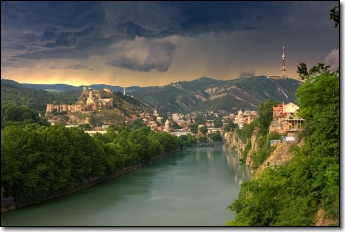|
Georgian history in brief
Fossilized bones have been found at the medieval village of Dmanisi. They are dated approximately 1.8 million years back in time, and are the oldest findings of human remains outside Africa. During Stone Age, humans gradually occupied the whole territory of today's Georgia. 6-7 thousand years ago humans started using metal, and already in the middle of the Bronze Age there were established unions of tribes in the eastern territory of Georgia. The rise of the early Georgian states took place in the 13th century BC with the creation of the first Kingdom of Colchis. The Kingdom later disintegrated and came under Persian control in the 7th century BC before it again revived. But in the 3rd - 4th century BC, Colchis weakened and was slowly destroyed. The eastern part of Colchis was during this period entering into the new strong eastern Georgian kingdom of Iberia. This was the first unified Georgian Kingdom under one king, King Parnavaz, established in the 4th century BC with Mtskheta as the capital.
After centuries under Roman control, King Mirian III declared Christianity as state religion in 337 AD. This contributed to development of literature, and also proved to be important for unification of the Georgian nation that was to come several hundred years later. From the 5th century feudalism gained foothold as the kingdoms dissolved and were divided. This made it easier for Persians and Arabs to invade the Georgian territories, esta- blishing and maintaining their strongholds. In spite of frequent invasions, the period between the 5th and 7th century was of great importance for the continuing growth in Georgian culture, especially for development of literature and architecture. Some of the oldest and most important literary works and architectural monuments belong to this period.
In the second half of the 10th century, King Bagrat III united major parts of the eastern and western Georgia, and in the next century King David Aghmashenebeli (the Builder) brought Georgia into the golden period. He expanded into Armenia in the south and towards the Caspian Sea in the east. King David Aghmashenebeli was well educated, and paid attention to construction of roads, bridges and infrastructure, as well as cultural/ educational centers like the monasteries of Gelati and Ikalto. The 12th century and the beginning of the 13th century represent the Golden Age for the Georgian Kingdom, the period of David the Builder and King Tamar. This period left a heritage of literature, poetry, art, philosophical thinking and great architectural monuments, etc.
|
|

Tbilisi - the old city and the river Mtkvari. Photo: Levan Chkhatarashvili © all rights reserved.
In the 14th century Tamerlane caused huge damage and destruction to Georgia. Furthermore, the defeat of Constantinople by the Ottoman Turks in the middle of the 15th century severed Georgia's contact with Christianity in Europe. The country went into a cultural and economic stagnation, contributing to the division of Georgia into smaller kingdoms at the end of the 15th century.
In 1783 Russia and the eastern Georgian Kingdom of Kartli-Kakheti and King Erekle II, signed a treaty promising Russian protection for eastern Georgia. The treaty also recognized the bonds of Orthodox Christianity between the Georgian and Russian peoples. Russia, however, did not provide support or help when both the Turks and Persians invaded at the end of the 18th century ransacking Tbilisi. Finally, in 1801 Russia violated the treaty with their annexation of Georgia. Except for a period of three years of independence from 1918 to 1921, Georgia remained under Russia and the Soviet Union until the most recent independence, which was declared on April 9th 1991.
|
|













